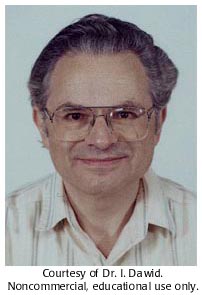Concept 36 Different genes are active in different kinds of cells.



 Igor Dawid and Tom Sargent did some of the first differential gene expression studies using cDNA subtraction. Pat Brown and Steve Fodor have changed the way genomes can be screened with DNA arrays and GeneChips®
Igor Dawid and Tom Sargent did some of the first differential gene expression studies using cDNA subtraction. Pat Brown and Steve Fodor have changed the way genomes can be screened with DNA arrays and GeneChips®
Igor Dawid (1935-2024)

Igor Dawid was born in Central Europe in what was Romania but is now part of Ukraine. There wasn't any defining event or moment that set him on a scientific career, especially since there wasn't too much science taught in his high school. However, he recognized that science was interesting and important. After World War II, Dawid went to Vienna to study.
The University of Vienna didn't have a biochemistry curriculum and given a choice between pure biology or chemistry, Dawid chose chemistry. He finished a Ph.D. in chemistry in 1960. By this time, he realized that to further his career, he needed to work in the United States. With help from his Ph.D. advisor, he obtained a post-doctoral position at the Massachusetts Institute of Technology. It was here that he pursued a growing interest in biochemistry. He read an article in a journal that talked about the isolation of a "factor" that induced tissues to change their fate. Even though the article was retracted a few months later, Dawid's interest was piqued and he decided to go to Woods Hole for a course in this growing field of tissue-specific genes.
At Woods Hole, Dawid met James Ebert, the director of the Carnegie Institute and later the director of Woods Hole. Ebert invited Dawid to work at the Carnegie and in 1962, Dawid became a Fellow and worked with Don Brown. Brown was using the traditional embryologist's model, frogs, to study development. Frog embryos are large and changes are easily visible. Also, a lot was known about the various stages of development. Dawid adopted frogs as a model system and continued to use them when he moved to the National Institutes of Health in 1978.
Tom Sargent joined his lab in the early '80s, and they began working on Sargent's idea of isolating differentially expressed mRNAs from different frog embryonic stages. The subtractive mRNA technique not only netted a lot of stage-specific mRNA, but worked surprisingly well in that the differential libraries had very little cross-stage contamination.
Since 1982, Dawid was the chief of Laboratory of Molecular Genetics at the National Institute of Child Health and Human Development, where he was also acting scientific director for two years. His lab in the Laboratory of Molecular Genetics Division worked on differential gene expression in frogs and zebrafish.
Dawid was the Editor-in-chief and served on the advisory board of the scientific journals Developmental Biology, and Proceedings of the National Academy. He was awarded the 2008 Lifetime Achievement Award from the Society for Developmental Biology. He was the Associate Editor of other journals, Cell and Genes and Development. He enjoyed classical music and was an opera buff.


GeneChip® technology is sensitive enough to detect single base pair differences, though the hybridization conditions must be ideal.

A-T pairs have two hydrogen bonds and G-C pairs have three. How would this affect the binding of DNA onto GeneChip® especially if the single nucleotide difference is an A to a G?
 DNA is packaged in a chromosome.
DNA is packaged in a chromosome. Higher cells incorporate an ancient chromosome.
Higher cells incorporate an ancient chromosome. Some DNA does not encode protein.
Some DNA does not encode protein. Some DNA can jump.
Some DNA can jump. Genes can be turned on and off.
Genes can be turned on and off. Genes can be moved between species.
Genes can be moved between species. DNA responds to signals from outside the cell.
DNA responds to signals from outside the cell. Different genes are active in different kinds of cells.
Different genes are active in different kinds of cells. Master genes control basic body plans.
Master genes control basic body plans. Development balances cell growth and death.
Development balances cell growth and death. A genome is an entire set of genes.
A genome is an entire set of genes. Living things share common genes.
Living things share common genes. DNA is only the beginning for understanding the human genome.
DNA is only the beginning for understanding the human genome.